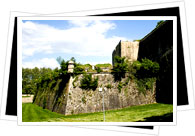From an architectural point of view, the vast, star-shaped Ciudadela is widely considered the best example of Spanish Renaissance military architecture, and is additionally thought to be one of the top defensive complexes in all of Europe. Built in the late 16th century, its construction comprised a major part of Spanish king Felipe II's plan to step up the defensive abilities of Pamplona. He enlisted the expertise of Giacomo Pelearo, an Italian military engineer who put into practice his home country's most recent theories on defensive architecture.
 La Ciudadela was built following a complex, star-shaped plan. The five points, two of which faced the city itself, were designed to be able to see and control all directions. Three of those five "baluartes" (bastions) remain today, as two of them were taken down to accommodate the expansion of the city and the construction of the aptly-named El Baluarte, a cutting-edge conference center and auditorium just outside of La Ciudadela. Today, El Baluarte hosts a wide range of cultural events and its auditorium is one of Pamplona's top venues for theater, dance and music performances, including those of the Orquesta Sínfonica de Navarra (Symphonic Orchestra of Navarra).
La Ciudadela was built following a complex, star-shaped plan. The five points, two of which faced the city itself, were designed to be able to see and control all directions. Three of those five "baluartes" (bastions) remain today, as two of them were taken down to accommodate the expansion of the city and the construction of the aptly-named El Baluarte, a cutting-edge conference center and auditorium just outside of La Ciudadela. Today, El Baluarte hosts a wide range of cultural events and its auditorium is one of Pamplona's top venues for theater, dance and music performances, including those of the Orquesta Sínfonica de Navarra (Symphonic Orchestra of Navarra).
Within La Ciudadela, the buildings that once held ammunition and supplies have been conserved, renovated and are today some of Pamplona's most interesting cultural spaces. El Polvorín, La Sala de Armas, El Horno and El Pabellón de Mixtos host art exhibitions, avant-garde installations and other cultural activities. In fact, La Ciudadela itself is like an open-air exhibition, as contemporary sculptures are dispersed throughout the parks and gardens, creating a wonderful atmosphere that combines leisure with culture.
Where to experience culture in La CiudadelaExhibitions